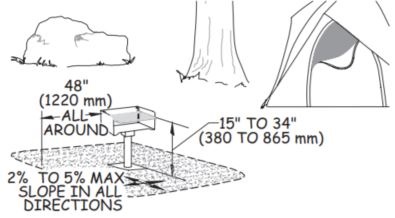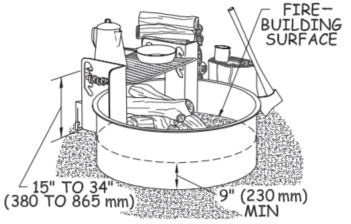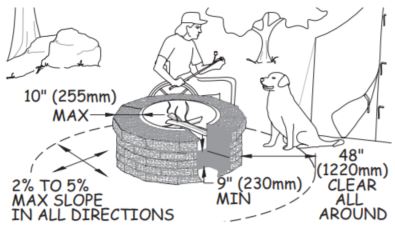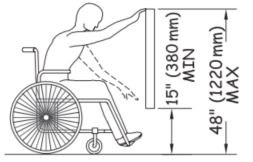Outdoor Developed Areas: A Summary of Accessibility Standards for Federal Outdoor Developed Areas
Fire Rings, Grills, Fireplaces, and Woodstoves [1011.2, 1011.3, and 1011.5]
A minimum of 48 by 48 inches of clear ground space must be provided on all usable sides of fire rings, grills, fireplaces, and woodstoves. The usable sides of these elements are the sides that can be used for building a fire or for cooking. All sides of fire rings and grills are generally usable, unless a wall or other structure on a side renders that side unusable. At least 48 inches of clear ground space must be provided around the entire fire ring or grill (figure 19). The front sides of fireplaces and woodstoves are generally the usable sides.

Figure 19—Requirements for clear ground space at a pedestal grill.
The fire-building surface within a fire ring must be at least 9 inches above the ground (figure 20). Fire rings that are constructed with two concentric walls reduce the chances that people using mobility devices and children will receive burns when the outside wall is touched.
The cooking surface must be between 15 and 34 inches above the ground. The cooking surface of pedestal grills may be adjustable beyond the required range, but must include adjustments within the specified range.

Figure 20—Height of the fire-building and cooking surfaces for fire rings.
Some custom-built fire rings and fireplaces may have a raised edge or wall around the fire-building area, perhaps built out of bricks or mortared stone. The depth or thickness of the raised edge or wall must not exceed 10 inches (figure 21).

Figure 21—Requirements for custom-built fire rings.
The operable parts of fire rings, grills, fireplaces, and wood stoves must be between 15 and 48 inches above the ground (figure 22). If an operable part, such as a handle or lever, falls outside this range during operation, it is not compliant. Operable parts must also be operable using one hand without tightly grasping, pinching, or twisting the wrist, and with no more than 5 pounds of force.

Figure 22—Reach requirements for operable parts.
Fire rings, grills, fireplaces, and woodstoves with compliant operable parts may not yet be commercially available. Until products with compliant operable parts become commercially available, compliance is required to the extent practicable.

User Comments/Questions
Add Comment/Question